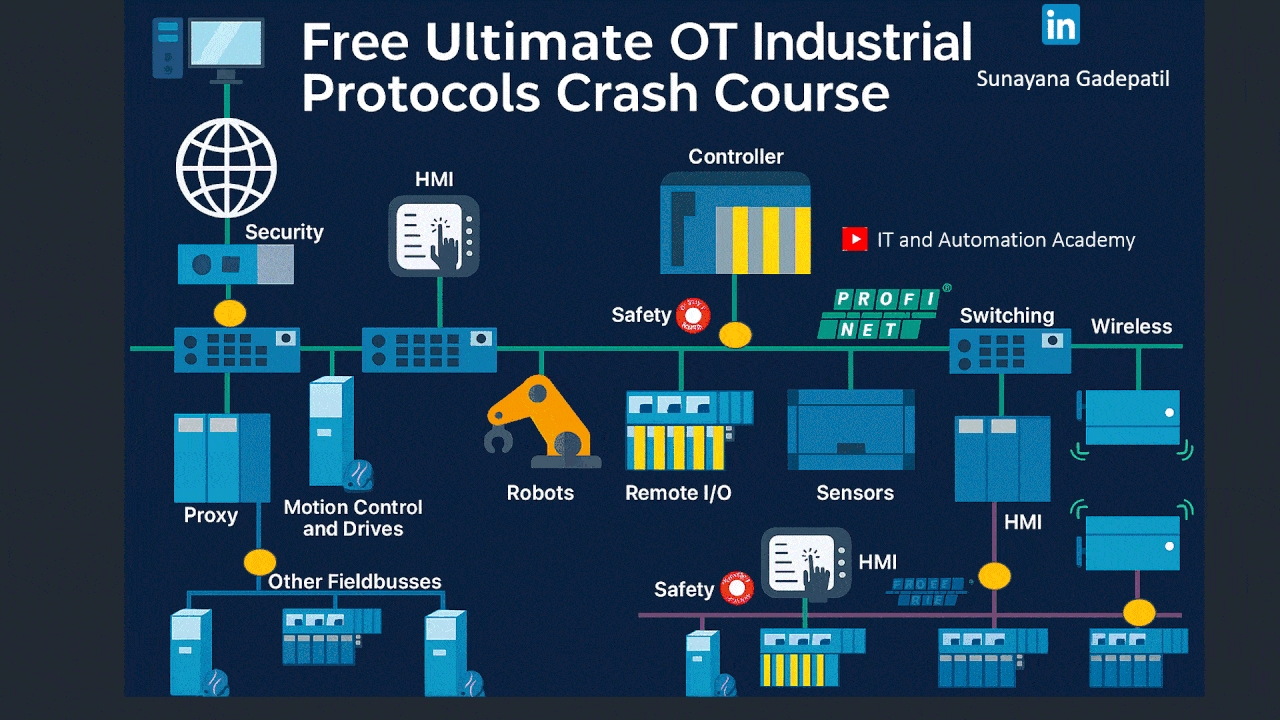- July 20, 2025
If you are planning a career in industrial automation or OT cybersecurity, there is one thing you must understand first — how machines talk to each other.
Machines in industries do not speak human languages — they use something called Industrial Network Protocols.
These are communication rules that help devices like PLCs, sensors, SCADA systems, and controllers exchange data reliably.
Table of Contents
ToggleThink of industrial protocols as the language of machines.
Just like we use English or Hindi to talk to each other, machines in factories or plants use protocols like Modbus, OPC, MQTT, Profibus, Profinet, and many more.
Without these protocols, automation wouldn’t be possible — because machines wouldn’t know how to share information.
We have put together a Free Crash Course that covers all the essential OT communication protocols used in PLC, SCADA, and DCS systems.
This course is perfect for:
And guess what? You don’t need any advanced knowledge. We will explain everything in simple terms.

Here’s a quick look at some of the most important protocols we’ll explore:
Each protocol will be explained with examples and simple diagrams so you can really visualize how communication happens in industrial environments. So Let us begin !
Let us start with one of the most popular protocols in the automation world – Modbus.
It is a communication method used to send data between devices like PLCs and sensors. There are two main types: Modbus RTU, which works over serial communication (like RS485), and Modbus TCP/IP, which works over Ethernet. It’s simple, reliable, and easy to learn.
“Perfect for beginners trying to understand how machines share information in an industrial setup.”
OPC UA stands for Open Platform Communications – Unified Architecture.
Don’t worry, the name sounds complex, but the idea is simple: OPC UA helps different devices and software talk to each other, even if they are from different brands. It’s secure, platform-independent, and great for modern automation systems.
In this tutorial, we will break it down in easy steps and show you how it all fits together.
MQTT stands for Message Queuing Telemetry Transport.
It is a lightweight protocol used in the Industrial Internet of Things (IIoT). Think of it like WhatsApp for machines — small, fast, and works even on low bandwidth. In industries, it is used to send data from sensors to cloud systems.
We will show you how MQTT works and why it’s becoming so important in smart factories.
PROFINET is a powerful protocol used mostly with Siemens systems. It works over Ethernet and allows real-time communication between devices in a plant.
In this lesson, we will explore how data flows in a PROFINET network, what devices are involved, and why it is preferred in many industrial applications today.
Ever wondered how we monitor and control a whole factory from a single screen?
That’s where SCADA comes in. In this tutorial, we will explain what SCADA is and how it communicates with field devices using OPC DA (Data Access).
You will learn how data is collected and displayed in real-time to operators, helping them make quick decisions.
Profibus and Profinet are both protocols developed by Siemens, but they work differently. Profibus is older and uses serial communication, while Profinet is newer and uses Ethernet.
In this video, we will compare both: their speed, structure, and where they are commonly used. It is a must-know for anyone working with Siemens systems.
Both RS-232 and RS-485 are serial communication standards used in industrial automation, but they have important differences.
RS-232 is used for simple, short-distance communication (like between a computer and modem), while RS-485 can connect multiple devices over longer distances.
In this session, we will explain how each works and when to use them in industrial projects.
In this tutorial, we will show you how Intouch SCADA (a popular HMI software) communicates with a Siemens S7-300 PLC using an OPC Server like Kepware.
It is a real-world example of how different systems connect and share data in industrial automation.
Step by step, you will see how the setup works and how to build this kind of connection yourself.
This crash course is your gateway into the world of industrial communication.
Watch each episode in the series to build your knowledge step by step.
By the end, you will understand how machines talk and you will be one step closer to becoming an automation or OT cybersecurity expert!
In association with IT And Automation Academy.
I hope you like above blog. There is no cost associated in sharing the article in your social media. Thanks for reading!! Happy Learning!!